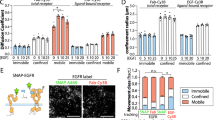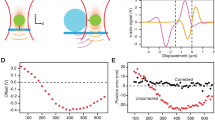Abstract
Lateral mobility of plasma-membrane proteins is now documented for a variety of cell systems. Evidence is accumulating that the molecular clustering allowed by such mobility may be important in the transduction of information at the cell surface1–7. Moreover, in a wide variety of systems, only a very small fraction of receptors need to be bound to induce a response8,9, such as in the mast cell/basophil system where receptor clusters as small as dimers can induce a response10 and only three or four such dimers are necessary for local degranulation11. As receptors are mobile, some clustering is expected even in the absence of ligand. As an approximate indication of the numbers involved, a consideration of constraints on translational entropy by spontaneous pair formation predicts12 about 100 pairs on average for a cell with 500,000 receptors (typical of mast cells13), if a pair is defined as two receptors whose peripheries are within 5 Å This estimate need not present a problem as it can be reduced by several orders of magnitude by postulating orientational requirements, repulsive potentials and/or more stringent constraints on tanslational entropy. Moreover, some cell preparations do show a slow Ca2+-dependent background release2 and this may, in fact, reflect spontaneous clustering and suggest that the control of activity is not stringent for those cells. An alternative view of the regulation of activity, however, which may have broad implications, is that receptors must be in proximity for some minimum amount of time for the transmission of biological information. This residency requirement may, for example, reflect the time required for the initiation of Ca2+ flow14 or for receptors to change conformation15 or for the pair to bind an integral membrane protein16. Whatever the origin, the quantitative predictions of the idea, which I develop here, suggest, for biologically relevant parameter values, an exceedingly sensitive control mechanism that can amplify the probability of an event by a factor of 1020 or more.
This is a preview of subscription content, access via your institution
Access options
Subscribe to this journal
Receive 51 print issues and online access
$199.00 per year
only $3.90 per issue
Buy this article
- Purchase on Springer Link
- Instant access to full article PDF
Prices may be subject to local taxes which are calculated during checkout
Similar content being viewed by others
References
Siraganian, R. P., Hook, W. A. & Levin, B. B., 12, 149–157 (1975).
DeLisi, C. & Siraganian, R. P. J. Immun. 122, 2286 (1979).
Dembo, M., Goldstein, B., Sobotka, A. K. & Lichtenstein, L. M. J. Immun. 122, 518 (1979).
Fanger, M. W., Hart, D. A., Wells, I. V. & Nisonoff, A. J. Immun. 105, 1484 (1970).
Archer, B. G. & Krakauer, H. Biochemistry 16 (1977).
Schechter, Y., Hernaez, L., Schiessinger, J. & Cuatrecasas, P. Nature 278, 835 (1979).
Kahn, C. R., Baird, K. L., Jarrett, D. B. & Flier, J. S. Proc. natn. Acad. Sci. U.S.A. 75, 4209 (1978).
Birnbaumer, L., Pohl, S. L. & Kaumann, A. J. Adv. Cylic Nucleotide Res. 4 (1975).
Schiessinger, J. in Physical Chemistry of Cell Surface Events in Cellular Regular (eds Delisi, C. & Blumenthal, R.) (Eisevier, Amsterdam, 1979).
Segal, D. M., Taurog, J. & Metzger, H. Proc natn. Acad. Sci. U.S.A. 74, 2993 (1977).
DeLisi, C. & Siraganian, R. J. Immun. 122, 2281 (1979).
DeLisi, C. Q. Rev. biophys. (in the press).
Metzger, H. & Bach, M. K. in Immediate Hypersensitivity (ed. Bach, M. K.) 561 (Dekker, New York, 1978).
Forman, J. C., Hallet, M. B. & Morgar, J. L. J. Physiol., Lond. 271, 193 (1977).
Hiedman, T. & Changeux, J. P. A. Rev. Biochem. 47, 317 (1978).
Bourguignon, L. Y. W. & Singer, S. J. Proc. natn. Acad. Sci. U.S.A. 74, 5131 (1977).
Eigen, M. in Quantum Statistical Mechanics in the Natural Sciences (eds S. L. Minz, & Weidermayer, S. M.) (Plenum, New York, 1974).
Bell, G. I. Science 200, 618 (1978).
Hammes, G. Adv. Protein Chem. 23, 1 (1968).
Berg, H. C. & Purcell, E. M. Biophys. J. 20, 193 (1977).
Metzger, H. Immun. Rev. 41, 186 (1978).
Schiessinger, J., Webb, W., Elson, E. L. & Metzger, H. Nature 264, 550 (1976).
Bergman, R. & Hechter, O. J. biol. Chem. 253, 3238 (1978).
Author information
Authors and Affiliations
Rights and permissions
About this article
Cite this article
DeLisi, C. The magnitude of signal amplification by ligand-induced receptor clustering. Nature 289, 322–323 (1981). https://doi.org/10.1038/289322a0
Received:
Accepted:
Issue Date:
DOI: https://doi.org/10.1038/289322a0
This article is cited by
-
Mechanism of the Antigen-Independent Cytokinergic SPE-7 IgE Activation of Human Mast Cells in Vitro
Scientific Reports (2015)
-
Receptor Oligomerization as a Process Modulating Cellular Semiotics
Biosemiotics (2010)
-
Mathematical and computational models of immune-receptor signalling
Nature Reviews Immunology (2004)
-
Microzones surrounding phytoplankton form the basis for a stratified marine microbial ecosystem
Nature (1985)
-
Stochastic problems in information transfer across the plasma membrane
Bulletin of Mathematical Biology (1983)
Comments
By submitting a comment you agree to abide by our Terms and Community Guidelines. If you find something abusive or that does not comply with our terms or guidelines please flag it as inappropriate.



